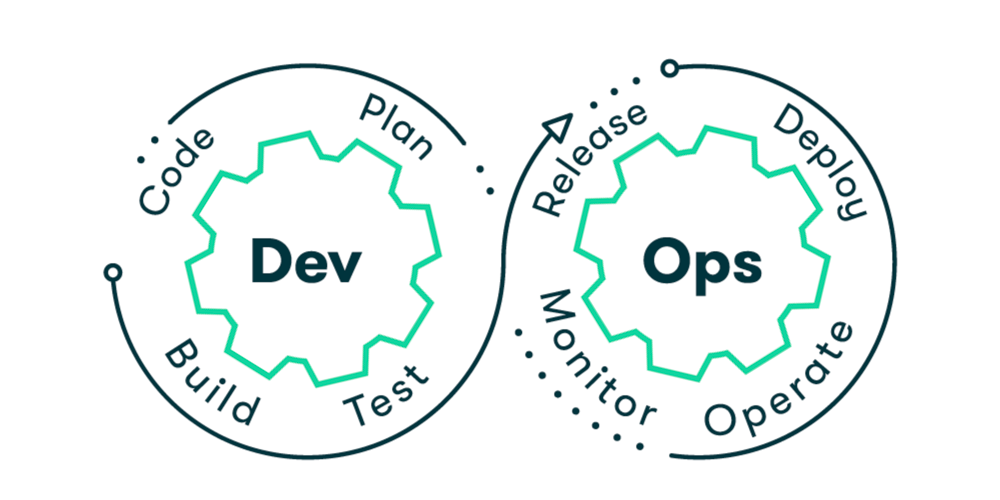


DevOps is considered to be the most suitable approach to agile software development that developers and operations team use to build, test, deploy and monitor applications with haste, quality and control.
DevOps pertains to any kind of software project regardless of its architecture, platform, or purpose. Cloud-native and mobile applications, application integration, modernization, and multi-cloud management are known to be the profound use cases of DevOps installation in a business.
Successful DevOps implementations generally rely on an integrated set of solutions or a "toolchain" to abstract manual steps, abbreviate errors, increment team agility, and to scale beyond minuscule, isolated teams.
DevOps hands us many advantages out of which the most important one being the reduction in the total number of sprints required to develop the end project. As compared to the traditional software methodology, DevOps uses agile methodology to speed up the work process
Continuous development is a term associated with iterative process in the view of developing software to be delivered to customers. The major steps here are continuous integration, continuous testing, continuous delivery, and continuous deployment.
With the implemention of a continuous development strategy and its corresponding sub-strategies, businesses can achieve rapid delivery of new features or products that often deal with higher quality and lower risk, avoiding significant bandwidth barriers.
Allows perpetual strategies to monitor and enforce desired configurations to tackle any unexpected changes.
A source control system additionally called a version control system, sanctions developers to collaborate on code and track changes. Source control is an essential tool for multi-developer projects.
Continuous integration (CI) is a software development practice frequently used in the DevOps process flow. This integration allows developers to regularly merge their code changes into a shared repository where in those updates are automatically tested.
With the help of Continuous Integration, most up-to-date and validated code is promised to developers. Costly delays in development can be minimized to zero with the help of CI due to the flexibility it provides to multiple developers to work on the same source code with confidence, rather than waiting to integrate seperate sections of code all at once on the release day
The CI/CD pipeline is your DevOps Pipeline automation engine that powers building and delivering your software applications through development, testing, and into production. Artifactory is the central “source of truth” for all the binaries your pipeline generates, providing the control and certainty that enables your CI/CD to deliver new releases more frequently and reliably.
A repository manager such as Artifactory plays an important role in the CI/CD process by providing a central place to store artifacts from builds that can be used in future builds. It might help to read user reviews for these types of tools on IT Central Station to see how users benefit from integrating a repository manager into the CI/CD deployment process.
Get assistance with Automated analysis and integration of code which is greater vital than ever. This provides support for your business with first-class integration.
Code quality scanning mechanism is essential to improve code quality. Code quality scanning is an automated system for rendering and providing code feedback. It serves as an interface like spell and grammar check for your code. For any project to work with outstanding performance Code quality maintenance and improvement serves as a key element and require attention throughout a project's lifecycle.
manages and represents the infrastructure (networks, virtual machines, load balancers, and connection topology) in a descriptive model. DevOps team uses the same versioning for source code. The principle itself defines that the same source code generates the same binary, and the IaC model generates identically the same environment every time it is applied. IaC is a fundamental DevOps practice which is a conjunction with continuous delivery.
Continuous delivery (CD) is the next subsequent logical step from CI. Automatic Code changes are built, examined, and packaged for launch into production. We aim towards providing users or the customers the release updates rapidly and sustainably.
To do this, CD automates the release process (building on the automated testing in CI). This renders new releases when the Onclick operation of a button is performed.
Configuration management is important in DevOps because it helps you automate otherwise tedious tasks and allows an organization to increase agility.Configuration management occurs when a configuration platform is used to automate, monitor, design and manage otherwise manual configuration processes. An important function of configuration management is defining the state of each system. By orchestrating these processes with a platform, organizations can ensure consistency across integrated systems and increase efficiency. The result is that businesses can scale more readily without hiring additional IT management staff. Companies that otherwise wouldn’t have the resources can grow by deploying a DevOps approach.
Configuration management is closely associated with change management, and as a result, the two terms are sometimes confused. Configuration management is most readily described as the automation, management, and maintenance of configurations at each state, while change management is the process by which configurations are redefined and changed to meet the conditions of new needs and dynamic circumstances.
Containerization holds a high influence on Cloud and DevOps, Essentially the trends hold an excessive impact on Cloud Computing and DevOps services with its advanced and superior solution for boosting and enhancing the infrastructure efficiency, Containerization-as-Service is now considered to be establishing its mark in the cloud’s as-a-service models.
Enormous impact is being made by the current established public cloud containers in addressing the needs of Dev and Ops team, thereby adding to the promising functioning of DevOps culture.
Meantime, growing DevOps adoption is driving many corporations to examine ‘Microservices structure’ for the subsequent stage of optimization in software program releases and preferrebly superior enhancement.
Enterprises moving to Cloud to improve operational efficiency with the business model of Pay As you go and leverage hardware resources (CPU/GPU) as required to build Data and AI-Driven applications.Containerisation of Application, Microservices, and Serverless architecture driving agility and portability of applications. Kubernetes leads the container orchestration and Management of Services. Devopscontainer is a leading Kubernetes Consulting and Solutions Provider for Enterprises to build Cloud-Native Application Development with DevOps Delivery pipeline, Big Data Analytics using Apache Spark.
We also provide Managed Kubernetes Services on Multi-Cloud Platform on Azure, Google Cloud, AWS, and Private Cloud as well as.
A verification process that allows developers to ensure that the code works the way it was intended to, in a live environment. Testing can surface bugs and particular aspects of the product that may need to be fixed or improved, and can be pushed back to the development stages for continued improvement.
A solid strategy is to deploy testers on demand for specific types of tests or specific functionality to the maximize test agility. For instance, testing one of your new functionalities on a wide range of mobile devices is required, but it can be difficult to assemble testers with the desired devices and configurations swiftly.
Your team should have measures in place for continuous monitoring and feedback of the products and systems until the end of the development pipeline. Majority of the monitoring process should be automated to provide continuous feedback.
This process enables the IT operations to identify the issues faced and notify the developers in real time. Continuous feedback ensure higher security and system reliability as well as more agile responses when issues do arise.
We monitor Application Resilience and enhance application migration to hybrid cloud or container deployments.
Considering the seasoned DevOps organization, continuous deployment serves as the better choice or the option over CD. Obeying the fact that Machines are more efficient than Humans, Continuous deployment with no intervention of humans describes the fully automated version of the CD..
In the Continuous deployment process, Iteration will be done and every validated change is automatically released or issued to users. The need for scheduled release days will be eliminated by this process and it accelerates the feedback loop. More prominent and frequent releases permit developers to deal with issues and to get users' remarks fast with more agility and accuracy.
Continuous deployment implies a high-quality purpose for the DevOps team. This process can be sufficient enough to be applied after the DevOps process has been rolled out. If you are an organization in concern to make continuous deployment work great, getting started with CI and CD with our outstanding services will help you get there.